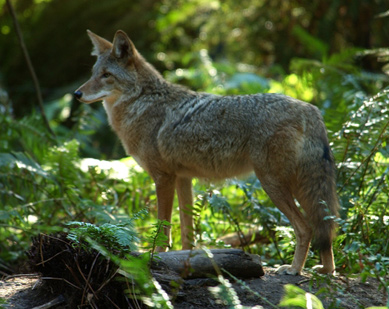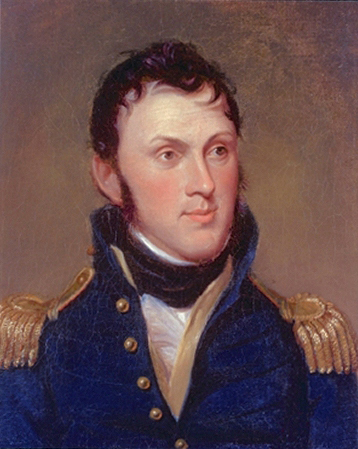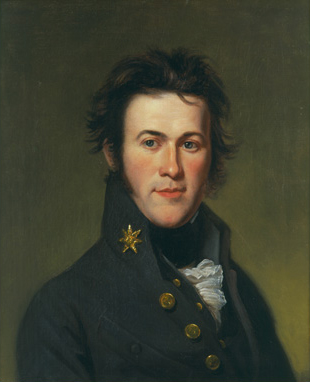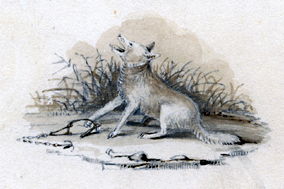“Wildest of all beasts is the wolf,
and wildest of all wolves is the coyote.”
“Prarie woolf” encounters
It was on 12 August 1804, northwest of today’s Onawa, Iowa, that Meriwether Lewis and William Clark first recognized the “Prarie[1]In his first dictionary, which he published in 1806, Noah Webster spelled the word prairy. His self-imposed mission was to establish a distinctive style of spelling that would be simpler than British … Continue reading wolf which was barking at us as we passed” like a large “fest,”[2]Properly “feist,” a Southern term for a small, snappy, nervous, belligerent little mongrel dog. The coyote is also known as a “song-dog” among many Indian peoples. and set out together to shoot a specimen for its scientific interest, but failed to even get a shot at it. A little over a month later, on 17 September 1804, one of the hunters brought in “a Small wolf with a large bushey tail,” and on the following day Clark himself scored “a Prarie Wollf, about the Size of a gray fox bushey tail head & ear like a wolf.” Lewis wrote his description of what proved to be a new species on 5 May 1805, in northeastern Montana.
the small woolf or burrowing dog of the praries are the inhabitants almost invariably of the open plains; they usually ascociate in bands of ten or twelve sometimes more and burrow near some pass or place much frequented by game; not being able alone to take deer or goat they are rarely ever found alone but hunt in bands; they frequently watch and seize their prey near their burrows; in these burrows they raise their young and to them they also resort when pursued; when a person approaches them they frequently bark, their note being precisely that of the small dog. they are of an intermediate size between that of the fox and dog, very active fleet and delicately formed; the ears large erect and pointed the head long and pointed more like that of the fox; tale long; . . . the hair and fur also resembles the fox tho’ is much coarser and inferior. they are of a pale redish brown colour. the eye of a deep sea green colour small and piercing. their tallons [claws] are reather longer than those of the ordinary wolf or that common to the atlantic states, none of which are to be found in this quarter, nor I believe above the river Plat.—
The call of the coyote frequently embellished the Corps of Discovery’s nighttime soundscape. At St. Michael’s Prairie near present St. Joseph, Missouri, On 11 September 1806 Lewis wrote:
Wolves were howling in different directions this evening after we had encamped, and the barking of the little prarie wolves resembled those of our Common Small Dogs that 3/4 of the party believed them to be the dogs of Some boat assending which was yet below us. the barking of those little wolves I have frequently taken notice of on this as also the other Side of the Rocky mountains, and their Bark so much resembles or Sounds to me like our Common Small Cur dogs[3]For more on the Cur dog, see Domestic Dogs. that I have frequently mistaken them for that Speces of dog.
At the time, Lewis’s “burrowing dog of the praries” seemed the most explicitly descriptive name for the species, but “prarie wolf” and “brush wolf” seemed appropriate also. No one in the Corps had yet heard of a “coyote.” An English-language version of the native (Nahuatl) Mexican word coyotl first appeared in print in 1824, proceeding from “coyjotte”[4]William Bullock (flourished 1808-1828), the author of Six Months’ Residence and Travels in Mexico (London, 1824), wrote that the coyjotte “seems to connect the wolf, fox and dog.” to “collates” to “cayeute” until it reached its orthographic terminus in the 1880s as “coyote,” now pronounced either ki-yoh-tee or ki-yote, depending on local preference or personal habit.
Natural History
European traders in on the upper Missouri had known of the prairie wolf for many decades, and Lewis’s added few details that were new. In fact, Nicholas Biddle, in his 1814 paraphrase of Lewis and Clark’s journals, condensed Lewis’s remarks to three sentences: “The large and small wolves of the plains principally inhabit the open country and the woodlands on their borders. They resemble, both in appearance and habit, those of the Missouri plains. They are by no means abundant in the plains of the Columbia, as they meet there but very little game for their subsistence.”[5]History of the Expedition of Captains Lewis and Clark, 1804-5-6 . . . . (2 vols., 1814), Chapter VII, “A general description of the beasts, birds, plants, etc., found by the party in this … Continue reading The first academic description for scientific purposes was published in 1823 by Thomas Say (see below), who classified it in the genus Canis (kay-nis; Latin for “dog”), and designated it as the species latrans (lay-tranz, “barking”).
Lewis’s estimate of the geographic distribution of the “prairie wolf” was significant, insofar as it provides a baseline for comparisons that show how its range has expanded during the past 200 years, and why. Coyotes learned during more than 20 million years of conditioning to stay out of wolf territory, but as the human population increased, wolves were virtually wiped out, and the coyotes naturally moved in to fill the void. They are somewhat less particular when it comes to daily sustenance, and the rodents that have multiplied around human settlements, farms and ranches, provide plenty of their favorite food. Today, although wolves have been re-introduced into parts of the American West, coyotes remain the dominant terrestrial predators from coast to coast, and from Central America to central Alaska. They have practically no competition from the lower mammals, and they continue to thrive despite the numerous and often unbelievably cruel ways that two-legged predators have devised to extirpate them.[6]A summary of the principal aspects of the species Canis latrans will be found in the Animal Diversity Web of the University of Michigan Museum of Zoology, … Continue reading
Among the nine North American species in the genus Canis, the coyote occupies a “medium-size” slot. The coyote the Corps, plus Sacagawea, Toby, and his son, ate for supper one night in late September 1805 wouldn’t have done much to fill 35 empty stomachs by itself, since a full-grown coyote in its best days tips the scale at somewhere between 25 and 35 pounds—head, tail, bones, innards and all.
Indian Legends
In real life the coyote’s name has come to stand for much of the worst behavior of which humans are capable, and there is a long list of uncomplimentary adjectives to prove it, although many have lost their sting now that most of us have been separated so far from wildness. On the other hand, the coyote is a prominent figure in North American Indian mythology; Nez Perce mythology is especially rich in that lore.
Coyote myths are not about coyotes in general, or as a species, but about “coyote” in the third-person singular—not “them” but “him.” He is prehistoric. He is ageless. He is as self-centered and frail as any human, but as liberal and omnipotent as any cosmical fantasy-fiction hero. He is a mentor, moralist, and master, yet he is not a god. He is the supreme trickster-transformer, though he is never malicious. He is at once “hot,” and “cool.” The ultimate tale about coyote is the one that relates how he re-created all the people from the bones and blood of the monster that had eaten them, saving the heart for the Nimi’ipuu—the real people,—and ending with the oracular announcement: “Only a short time away is the coming of the human race.”[7]Deward E. Walker, Jr, and Daniel N. Matthews, Nez Perce Coyote Tales: The Myth Cycle (Norman: University of Oklahoma Press, 1994), 3-11. The “heart of the monster” is part of the Nez … Continue reading
Stephen Harriman Long, (1784–1864)
by Charles Willson Peale (1819)
Montage depicting complete oil painting by Pete Hobbs and licensed under the Creative Commons CC0 1.0 Universal Public Domain Dedication.
The Long Expedition
It is instructive to compare Meriwether Lewis’s description of the coyote with the definitive work done by Thomas Say (1787-1834). Lewis was primarily a soldier and explorer who incidentally was endowed with the experience and intellectual capacity that enabled him to function effectively as an amateur naturalist. Thomas Say, thirteen years younger than Lewis, was a professional scientist. Although self-taught, as was common in his day, he became a charter member of the Academy of Natural Sciences at the age of twenty-five. One of his two major achievements was the trail-breaking American Conchology, or Descriptions of the Shells of North America (Philadelphia, 1836). The other was American Entomology, or Descriptions of the Insects of North America (3 volumes, Philadelphia, 1824-1828), which held major importance for the future of both medicine and agriculture in the U.S. In 1819 Say was chosen as a member of one of Stephen Long’s government-sponsored expeditions.[8]Patricia Tyson Stroud, Thomas Say, New World Naturalist (Philadelphia, University of Pennsylvania Press, 1992).
The expedition commanded by Major Stephen H. Long in 1819-20 was initiated by John C. Calhoun (1782-1850), the secretary of war under James Monroe’s administration (1817-25). It was conceived mainly as a means of consolidating American power and influence in the West in the face of continuing efforts of Great Britain to undermine the American fur trade. For that purpose an advance military contingent numbering about a thousand men set out up the Missouri in steamboats in 1818. Like Lewis and Clark’s expedition, it was represented publicly as a scientific undertaking, and included a team of naturalists—a botanist, a geologist, and two artists. Titian Ramsay Peale, a son of the portraitist Charles Willson Peale, served as illustrator and assistant naturalist; Samuel Seymour was the landscape artist.[9]Samuel Seymour (1774-1823) accompanied the detachment of Long’s expeditionary force that explored the upper Platte River. Two of his watercolors, “Distant View of the Rock … Continue reading The zoologist was Thomas Say.[10]Major Thomas Biddle, brother of Nicholas Biddle, was to serve as journalist for the expedition. Another member of Long’s expedition was a nephew of William Clark, Major Benjamin O’Fallon, … Continue reading
The scientists originally were expected to donate their services. All were encouraged to perform “in such a manner, as to add both to their own reputation and that of our country.” To supplement those intangibles, each was eventually offered an honorarium of two dollars per day, a respectable sum in the context of the times. Unfortunately, the expedition fell considerably short of the achievements of Lewis and Clark, owing to a succession of misjudgments and misfortunes, plus a Congressional budget cut that reduced its duration and revised its objectives. The revised plan was to divide the expedition into two contingents in order to explore “the Missouri and its principal branches,” including the Arkansas River, the Red River of the South (whose source Jefferson’s Freeman-Custis Expedition of 1806 had failed to reach), and the Mississippi above its confluence with the Missouri.
Major Long’s original orders, issued by Calhoun, amounted to a one-page summary of those Jefferson sent to Lewis in June 1803, and concluded: “The Instructions of Mr. Jefferson to Capt. Lewis, which are printed in his travels; will afford you many valuable suggestions, of which as far as applicable, you will avail yourself.”
Say’s studies of Indian ethnology were important accomplishments for his time. His contributions to the biological sciences during the expedition were the first definitive descriptions of eight passerine birds new to science, plus the swift fox, the mule deer, the timber wolf and Canis latrans.
Say’s Canis latrans
Say conducted his study of the prairie wolf in September of 1819 at the expedition’s winter encampment on the site of Lewis and Clark’s Council Bluffs, fifteen miles up the Missouri River from the mouth of the Platte. He had the first edition of the Lewis and Clark journals in hand, which contained Biddle’s edited version of Lewis’s observations dated 5 May 1805.
Say’s description of Canis latrans, together with the rest of his taxonomies, were published in 1823 as an annotation to the report compiled by Edwin James, who also served as a botanist and geologist for the expedition:[11]Account of An Expedition from Pittsburgh to the Rocky Mountains performed in the years 1819 and ’20, by order of the Hon. J.C. Calhoun, sec’y of war: under the command of Major Stephen H. … Continue reading
Canis latrans. Cinerous [gray-black] or gray, varied with black above, and dull fulvous [dull brownish-yellow], or cinnamon: hair at base dusky plumbeous [dull gray], in the middle of its length dull cinnamon, and at tip gray or black, longer on the vertebral line; ears erect, rounded at tip, cinnamon behind, the hair dark plumbeous at base, inside lined with gray hair; eyelids edged with black, superior eyelashes black beneath, and at tip above; supplemental lid margined with black-brown before, and edged with black brown behind; iris yellow; pupil black-blue; spot upon the lachrymal sac [tear duct] black-brown; rostrum [snout] cinnamon, tinctured with grayish on the nose; lips white, edged with black, three series of black seta [whiskers]; head between the ears intermixed with gray, and dull cinnamon, hairs dusky plumbeous at base; sides paler than the back, obsoletely fasciate [flattened] with black above the legs; legs cinnamon on the outer side, more distinct on the posterior hair: a dilated black abbreviated line on the anterior ones near the wrist; tail bushy, fusiform [tapering at both ends], straight, varied with gray and cinnamon, a spot near the base above, and tip black; the tip of the trunk of the tail, attains the tip of the os calcis, when the leg is extended; beneath white, immaculate, tail cinnamon towards the tip, tip black; posterior feet four toed, anterior five toed.
Feet Inches Total Length, (excepting the hair at tip of tail) 3 9½ Trunk of the tail 1 ½ Hind foot os calcis [heel bone] to tip of claw, 7½ Four [fore-]foot, elbow to tip of claw, 1 ¾ Ears from top of head, 4 Rostrum [snout] from anterior canthus [corner] of the eye 3¾ Taken in a trap, baited with the body of a wild cat.
The line on the anterior side of the anterior feet, near the wrist, is wanting in a second specimen.This species varies very much in size, another specimen measured in total length, excepting the hair at the tip of tail 3 2½ Tail [excepting the hair at tip of tail] 2½ Ear, from top of head to tip 3 5/8 The snout was narrower than in the preceding specimens, but in colour similar Another specimen was destitute of the cinnamon colour, excepting on the snout, where it was but slightly apparent; the general colour was, therefore, gray with an intermisture of black, in remote spots and lines, varying in position and figure with the direction of the hair.
The prairie wolves roam over the plains in considerable numbers, and during the night, the principal season of their hunts, they venture very near to the encampment of the traveler. They are by far the most numerous of our wolves, and often unite in packs for the purpose of chasing deer, which they very frequently succeed in running down, and killing. This, however, is an achievement attended with much difficulty to them, and in which the exertion of their utmost swiftness and cunning, are so often unavailing, that they are sometimes reduced to the necessity of eating wild plums, and other fruits, to them almost indigestible, in order to distend the stomach, and appease in a degree the cravings of hunger.
“Prairie wolf in distress”
by Titian Ramsay Peale (1819)
American Philosophical Society, Philadelphia, 1144-153.
The role that Major Long’s two artists shared was to illustrate various scenes and situations in the expedition’s written record. In this instance, as gruesome as it is, Peale captured one aspect of exploration and discovery at a more dramatic moment than was typically portrayed in a scientific depiction of an animal.
Their bark is much more distinctly like that of the domestic dog, than of any other animal; in fact the first two or three notes could not be distinguished from the bark of a small terrier, but these notes are succeeded by a lengthened scream.
The wonderful intelligence of this animal, is well worthy of note, and a few anecdotes respecting it may not be amiss. Mr. Peale constructed and tried various kinds of traps to take them, one of which was of the description called “a live trap,” a shallow box reversed, and supported at one end, by the well known kind of trap sticks, usually called the “figure four,” which elevated the front of the trap upwards of three feet above its slab flooring; the trap was about six feet long, and nearly the same in breadth and was plentifully baited with offal. Notwithstanding this arrangement, a wolf actually burrowed under the flooring, and pulled down the bait through the crevices of the floor; tracks of different sizes were observed about the trap. This procedure would seem to be the result of a faculty beyond mere instinct.
This trap proving useless, another was constructed in a different part of the country, formed like a large cage, but with a small entrance on the top, through which the animals might enter, but not return; this was equally unsuccessful; the wolves attempted in vain to get at the bait, as they would not enter by the rout prepared for them.
Peale’s objective in attempting to trap a coyote was to acquire a live specimen for a model. Unfortunately, the only trap that worked was a deadfall, which killed the animal.
Notes
| ↑1 | In his first dictionary, which he published in 1806, Noah Webster spelled the word prairy. His self-imposed mission was to establish a distinctive style of spelling that would be simpler than British or French practice, and phonetically closer to common pronunciations among educated Americans. Sometimes he succeeded, as with the word neighborhood, which Lewis as well as the orthographically challenged Clark invariably spelled Britanically—neighbourhood. In the case of prairy, however, Webster’s compromise failed to stick, and the French spelling remains intact today. |
|---|---|
| ↑2 | Properly “feist,” a Southern term for a small, snappy, nervous, belligerent little mongrel dog. The coyote is also known as a “song-dog” among many Indian peoples. |
| ↑3 | For more on the Cur dog, see Domestic Dogs. |
| ↑4 | William Bullock (flourished 1808-1828), the author of Six Months’ Residence and Travels in Mexico (London, 1824), wrote that the coyjotte “seems to connect the wolf, fox and dog.” |
| ↑5 | History of the Expedition of Captains Lewis and Clark, 1804-5-6 . . . . (2 vols., 1814), Chapter VII, “A general description of the beasts, birds, plants, etc., found by the party in this expedition,” xxx. |
| ↑6 | A summary of the principal aspects of the species Canis latrans will be found in the Animal Diversity Web of the University of Michigan Museum of Zoology, http://animaldiversity.ummz.umich.edu/site/accounts/information/Canis_latrans.html. For a treatment of its place in 21st-century life, see John Trout Jr., Solving Coyote Problems: How to Outsmart North Ameica’s Most Persistent Predator (Guilford, Conecticut: the Lyons Press, 2000). |
| ↑7 | Deward E. Walker, Jr, and Daniel N. Matthews, Nez Perce Coyote Tales: The Myth Cycle (Norman: University of Oklahoma Press, 1994), 3-11. The “heart of the monster” is part of the Nez Perce National Historical Park; it is pictured at http://www.nps.gov/nepe/site15.htm, and an abbreviated version of the legend is related by Nez Perce historian Allen Slickpoo at http://www.ilhawaii.net/~stony/lore47.html. |
| ↑8 | Patricia Tyson Stroud, Thomas Say, New World Naturalist (Philadelphia, University of Pennsylvania Press, 1992). |
| ↑9 | Samuel Seymour (1774-1823) accompanied the detachment of Long’s expeditionary force that explored the upper Platte River. Two of his watercolors, “Distant View of the Rock Mountains,” and “View of the Rocky Mountains on the Platte 30 Miles from their Base” (1820), which were included in the final report, were the first known images of the Rockies to be published. Little else remains of Seymour’s total output. |
| ↑10 | Major Thomas Biddle, brother of Nicholas Biddle, was to serve as journalist for the expedition. Another member of Long’s expedition was a nephew of William Clark, Major Benjamin O’Fallon, who had recently been appointed agent for Indian Affairs in the Missouri Territory. Traveling with the advance party, O’Fallon’s responsibility was to pave the way for friendly receptions of the expeditionary force by Indian tribes along the Missouri, and ultimately to establish the new policy for Indian-American Trade: No British Allowed. Stroud, Thomas Say, 85-86. |
| ↑11 | Account of An Expedition from Pittsburgh to the Rocky Mountains performed in the years 1819 and ’20, by order of the Hon. J.C. Calhoun, sec’y of war: under the command of Major Stephen H. Long. From the notes of Major Long, Mr. T. Say, and other gentlemen of the exploring party. Comp. by Edwin James, botanist and geologist for the expedition. (2 vols., Philadelphia: H. C. Carey and I. Lea, 1822-23), 1:172. “Mr. Peale” was Rembrandt Peale, a son of artist Charles Willson Peale, of Philadelphia. |




